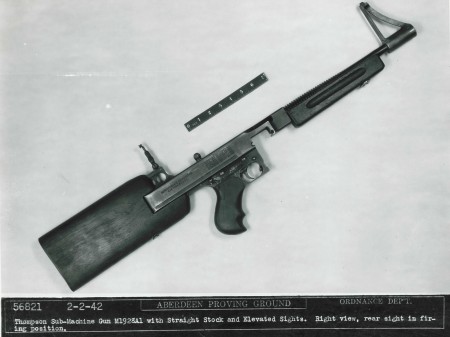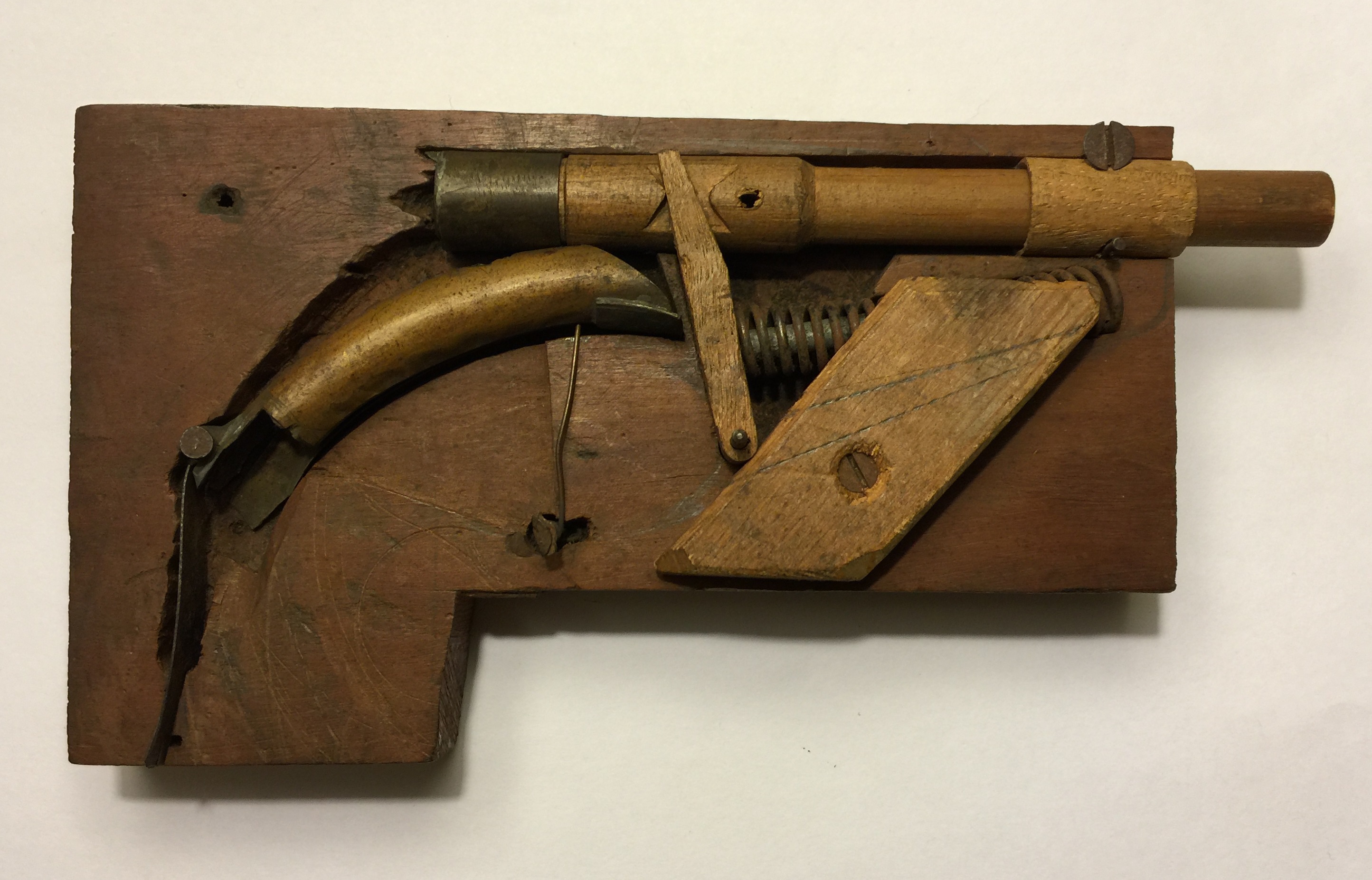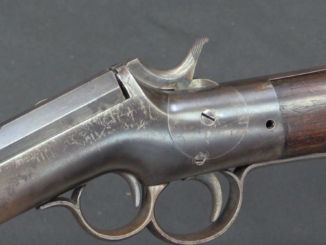Sorry, things are a bit light this week – more good stuff coming next week. For today, I have an interesting Aberdeen Proving Grounds catalog photo of an experimental stock for the Thompson SMG. Presumably this was intended to reduce the gun’s tendency to climb in full-auto fire. No idea how well it worked, but obviously not well enough to be adopted. Anyone have more information about this line of testing?





Is that a sort of small foldable diopter sight ?
The rear sight looks a lot like a Lyman tang aperture sight
http://www.lymanproducts.com/lyman/sights/1894.php
Just by the looks of it, climbing must have been decreased a lot (especialy since the original thompson stock must have been among the worst designs ever in production in that aspect).
However, sights seem very high in contrast to barrel level. I know from own experience with just the AK (Rk62-95) in fieldconditions its not rare you see your target through the sights, while bullets might go straight into a log or rock 1 meter in front of you. This variation with its extremely high sights must have had a lot of user problems similar to that.
In general, it just looks akward to handle.
Someone who owns a Thompson should try to build a replica of it, cant be to difficult!
And when you run out of ammo you can use it to paddle
your raft…
The front sight is like some kind of a “reverse johnson” LMG sight but not quite. The rear could be Johnson LMG sight parts.
Does this thing have a year of manufacture?
I understand the principle- put the bore in line with, or below, the shoulder, to allow the shooter to get on top of the gun and have better control over muzzle rise. However, it looks to have made a heavy gun even heavier and more unwieldy.
Image won’t load….”contains errors”
A Tommie was just a guinea pig in this case, as the Aberdeen program was only to research the effectiveness of the in-line stock idea. Standard Savage Tommie s/n S-25618 was fitted with the exprimental stock fabricated by the personnel of the Aberdeen Proving Ground and a series of tests were conducted to assess the muzzle climb control properties of the in-line layout. Two configurations of the straight line Tommie are known, one with Cutts compensator, A-shaped front sight base and micrometer rear peep (the one illustrated above) and the other without Cutts compensator, with I-shaped front sight base and long rear sight leaf with fixed peep hole installed in a standard M1928A1 rear sight base. Also, two shapes of the stocks were made, differing in height of the stock centerline in comparison to the height of the barrel centerline. The one with straight in-line stock (illustrated above) was chosen as the more comfortable over the other with centerline above the barrel axis. The experiments was conducted between January 5 and March 7, 1942.
In the first test at 25 yds, shooting FA at a target 6×6 ft, standard Tommie s/n 5904 with Cutts compensator achieved 74% hits, while experimental with Cutts scored 98%. Curiously, standard TSMG w/o Cutts climbed to 91% all by itself, while straight-stock sans Cutts shot 99% hits.
The test was then repeated at 50 yds. Standard buttstock and Cutts scored lowly 49%, in-line with Cutts – 79%, while without Cutts the scores were 61% and 81% respectively. Smoke over the compensator slits and obscuring target was given as the main reason for the decrease of scoring with Cutts in place. The virtues of in-line stock were confirmed – and this experiment was the last straw that determined, that the new M1 straight blowback no-fuss Thompson lost the Cutts compensator.
[This above written based on American Thunder II by Frank Iannamico, pp. 477-478]
Thanks Leszek
You’ve confirmed what I’ve guessed for a while.
Even on a purely theoretical basis, I’ve got to wonder why the Cutts was ever seen as anything but an expensive ornamental weight on the muzzle of a long barreled 45ACP (a round with 18 to 20K PSI peak pressure, and low single figures K PSI at the muzzle…).
Now I know, it was actually worse than useless.
Good stuff, Leszek.
Actually, I have always thought the Thompson quite controllable and accurate despite the drop of the stock. Of course, I’ve never shot magdumps from one, only short bursts (training dictates that). At usual urban/forest combat ranges it’s a very accurate weapon. I attribute that to the weight, which lets even an open-bolt gun shoot accurately (the bolt is heavy, but not compared to the gun!).
The numbers you cite bear this out. With the centerline stock, the weapon is more accurate in auto fire, but without it is not bad.
Kevin,
I concur about the controllability of the Thompson. Truth; a Thompson is a big’ole heavy gun, especially when loaded with 30 stick or 50 drum. Having never actually seen a hundred drum in real life, much less held/fired one, I’ll have to defer on that point but I’ll have to assume, being a colossally heavy gun/loaded mag unit, the issue would be not so much holding it down but rather holding it up.
Remember, it’s launching not particularly high velocity PISTOL rounds.
Back in the day (1960s) and having access to a 1928 and way too much out-of-inventory-outdated (early 1940s) vintage .45 ACP, plus almost no adult supervision, we had an interesting ongoing “product review” going on.
Cut to the chase; The legendary “control” issues of the Thompson originated from poor or no training squandered on the ignorant and/or inexperienced. Hey, those kids had mostly never even seen a machine-gun, much less touched one.
The more analytical of us came to the simple conclusion the error was in REACTING to the recoil and climb after commencing fire rather than PREPARNG beforehand. Do that and of course it’s going to climb before one’s reflexes can compensate.
Like Kevin, I found it quite accurate and incidentally, very reliable with few, if any, failures to fire with the 25 or so year old ammo. Even more remarkable, I ended up with some of that batch of .45 ACP and occasionally try a few rounds.
Still works nearly 50 additional years later.
Go figure.
By how much does a Cutts compensator reduce muzzle rise of a 1921AC Thompson, compared to a 1921 model with no compensator?